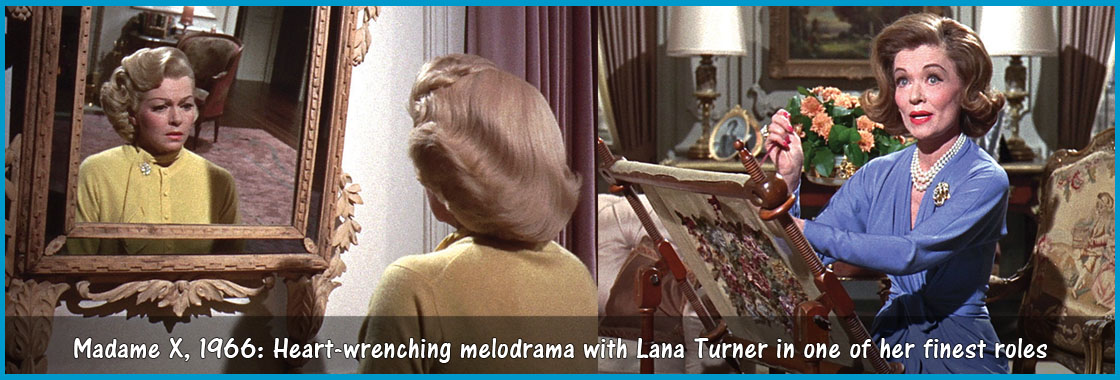Madame X - Lana Turner's finest performance
The following is an extract from the Blu-ray booklet From Lana Turner to Madame X.
If Rhonda Fleming, with Maureen O’Hara and Susan Hayward, were hailed as “The Queen of Technicolor”, then surely Lana Turner, with Bette Davis and Joan Crawford, would be at least short-listed as “The Queen of Melodrama”.
Julia Jean Turner was born in Wallace, Idaho on February 8, 1921 to Mildred Frances Cowan and John Virgil Turner. Her parents were never flush with cash and so Julia stayed with several families while her mother tried to make ends meet. Although not Catholic, she attended a Catholic school, and during a period staying with the Hislop family in Stockton, San Francisco, went with them to Catholic church. She decided to convert and so needed a saint’s name for her confirmation. She decided to add her mother’s two given names and became Julia Jean Mildred Frances Turner.
It was while staying in Stockton that she was taken on a surprise visit to meet her mother, who told her that her father was dead. Virgil Turner was an excellent card player and sometimes played with a travelling crap game. On the night of December 30 1930, after a game in the basement of the San Francisco Chronicle building, he had a good win and told the other players he would buy his daughter a bicycle. Virgil put his winnings into his left sock and was later found battered to death, his left foot bare. No one was ever brought to justice for his murder.
Judy (Julia Jean’s nickname at the time) moved to and loved Hollywood, and began attending Hollywood High. Her pocket money would only stretch to a Coke, which cost a nickel in the Top Hat Café. One day, the fifteen-year-old was approached by a stranger, who asked if she would like to be in movies and gave her his card so her mother could make an appointment. The name on the card was W. R. (Billy) Wilkerson of the Hollywood Reporter.
Gladys Taylor, with whom the Turners were living, took her the next day to meet Mr Wilkerson, who wrote a letter of introduction to Zeppo Marx, who had left the Marx Brothers to start a talent agency. On their first meeting Marx insisted that Judy should pretend to be eighteen not fifteen, saying “As far as this industry goes, you’re eighteen.”
This led to a meeting with director Mervyn LeRoy and her first film part in Warner Brothers’ They Won’t Forget (1937), for which she was paid $50 a week. Not happy with her real name, LeRoy toyed with Leonore and Lurlene, until the young girl suggested Lana! “That’s it,” he said, ”You’re Lana Turner!” And so, the career in which was to create the Hollywood legend of Lana Turner was begun. She gave her first cheque to her mother saying “You’ll never have to work again.”
Madame X is based on Alexandre Bisson’s stage which opened in Paris on December 15 1908. An English translation by John Raphael opened in New York City on 2 January 1910 and ran to 125 performances. Madame X has been filmed several times, most notably with Ruth Chatterton and Lewis Stone, directed by Lionel Barrymore in an early sound version of 1929, and Gladys George and Warren William, directed by Sam Wood (A Night at the Opera) and Gustav Muchaty in the 1937 productions. Both of these were MGM productions. Tuesday Weld and Jeremy Brett also starred in a Universal TV movie of the play in 1981, directed by Robert Ellis Miller.
Lana Turner's performance in Madame X, is regarded by many as her finest screen role, and now available on Blu-ray, DVD and Dual Format.
